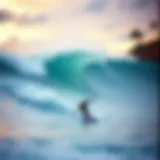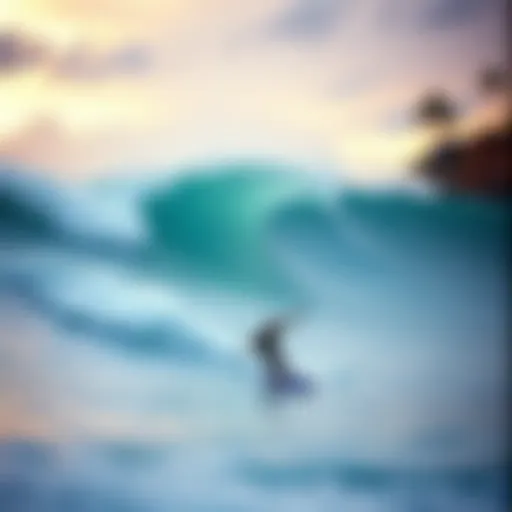Ultimate Guide to Longboard GoPro Mounts


Intro
Longboarding has gained substantial traction in recent years, attracting thrill-seekers and extreme sports enthusiasts alike. One aspect that enhances the longboarding experience significantly is the use of GoPro mounts. This guide presents an extensive exploration of the available GoPro mounts tailored for longboarders. Whether you are new to the sport or an experienced rider looking to elevate your footage quality, this guide will provide you with vital insights and techniques.
Capturing high-quality footage while longboarding is not just about creativity; it involves understanding the right mounts, installation techniques, and positioning. The following sections will provide a detailed look into various mount types, safety measures, and essential gear that enhance performance and content creation. Each aspect plays a crucial role in documenting your adventures, ensuring that every ride is memorable through quality visuals.
Techniques and Tips
Skill Development
Before setting out to capture the terrain on your longboard, honing your riding skills is paramount. Riders should be comfortable with both carving and cruising, as these movements can impact how the camera captures the ride. Practicing different techniques will allow you to hold steadier footage and maneuver while keeping your focus on the camera operation.
Practical Techniques
To maximize the quality of your videos, consider the following practical tips:
- Stable Mounting: Using a chest mount is often recommended for stability. This position helps in minimizing the shakes common with handheld shots.
- Adjust Camera Settings: Set your GoPro to a higher frame rate for smoother footage. This knowledge allows you to adjust clarity based on the speed of your descent.
- Experiment with Angles: Try different mount placements such as helmets, side of the board, or even handheld shots to see what works best for your filming style.
Common Mistakes to Avoid
Many enthusiasts tend to overlook important factors that can lead to subpar footage:
- Ignoring Lighting Conditions: Filming in poor light often yields disappointing results. Aim to record in optimal lighting for better video quality.
- Neglecting Camera Settings: Not adjusting your camera settings according to environmental factors can lead to grainy or shaky footage.
Gear and Equipment
Essential Gear for Beginners
For newcomers, investing in basic yet reliable gear is essential. Recommended essentials include:
- A sturdy GoPro camera with compatible mounts
- A chest strap mount for stability
- Extra batteries and memory cards to ensure that you capture every moment
Latest Innovations and Trends
The longboarding community is continuously evolving, and so is the technology that accompanies it. Keeping abreast of newer model releases and improved mounts is crucial. Brands like GoPro are consistently updating their product lines with innovations that enhance capture quality and usability.
Reviews and Comparisons
Reading reviews from fellow riders can help in making informed decisions. Websites like reddit.com feature discussions comparing different GoPro mounts.
Safety Measures
Essential Safety Gear
When heading out, ensure that you have the right safety equipment:
- Helmet: A properly fitted helmet is vital.
- Elbow and Knee Pads: These protect against falls and scrapes.
- Wrist Guards: Enhance safety and reduce injury risk.
Best Practices for Safe Participation
Engaging in longboarding with a camera may distract from safety. Follow these best practices:
- Establish a clear path free of obstacles.
- Maintain a speed that you are comfortable controlling.
Injury Prevention and Management
Being proactive about preventing injuries can save more than just pain. Ensure your gear is in good condition. Familiarize yourself with basic first-aid practices for minor injuries.
Spotlights on Extreme Sports
Featured Sport of the Month
Longboarding stands out this month as an exciting sport, allowing enthusiasts to connect with nature while showcasing stunning scenery through recording.
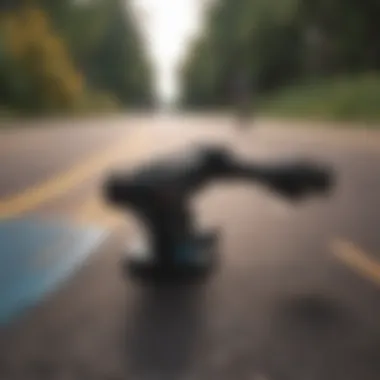

Profiles of Prominent Athletes
Highlighting prominent longboarding athletes can inspire newcomers. Many athletes share their journeys through social media or video blogs, providing useful insights into gear, techniques, and overcoming challenges.
"When you feel the wind rush past as you capture the beauty around you, there’s nothing quite like it." – Anonymous Longboarder
Closure
In summary, mastering GoPro mounts while longboarding takes dedication and practice. This guide aims to empower both novice and seasoned riders to elevate their content through valuable insights, safety tips, and gear recommendations. By understanding the importance of each detail, you can enhance your longboarding experience and create stunning visuals that capture your adventures.
Prelude to Longboard GoPro Mounting
Longboarding has surged in popularity, both as a recreational activity and an extreme sport. Riders seek to capture their experiences through various angles, and this is where GoPro mounting becomes crucial. The right mounting system allows enthusiasts to film their rides hands-free, showcasing their skills and adventures without compromising safety. A well-placed camera can transform an ordinary run into an exhilarating visual journey.
Understanding the Need for Mounts
The primary requirement for mounts stems from the necessity of stability and accessibility. When longboarding, riders need both hands on the board to maintain control. Using a GoPro mount means the camera can stay secure while capturing high-definition footage. This not only enhances the quality of the recordings but also allows for creativity in angles. Different mounts provide varied perspectives, from over-the-head views to chest-level angles, giving viewers a comprehensive view of the longboarding experience.
The Rise of Action Cameras in Extreme Sports
Action cameras, particularly the GoPro series, have revolutionized how extreme sports are documented. Their compact design, durability, and superior video quality have made them a go-to choice for athletes and adventure seekers alike. For longboarders, the ability to record high-speed runs, trick performances, and scenic routes is invaluable. These cameras have significantly lowered the barrier for creating engaging content that showcases both skill and adventure.
The popularity of social media platforms has further fueled the rise of action cameras. Riders can instantly share their experiences, reaching a broader audience and inspiring others. In essence, the combination of thrilling footage and connectivity plays a significant role in the culture of extreme sports today.
Types of GoPro Mounts for Longboarding
In the realm of longboarding, capturing your most exhilarating rides has never been easier thanks to the array of GoPro mounts available. Understanding the different types of mounts provides longboarders with the tools to create stunning, immersive videos of their exploits. Each mount offers unique advantages and can influence the quality and perspective of the footage captured. With the right mount, riders can showcase their skills while enhancing their storytelling through video.
Helmet Mounts
Helmet mounts are a go-to option for many longboard enthusiasts. They provide a direct point of view, allowing viewers to experience the ride as if they are in the rider's shoes. This perspective can effectively communicate the thrill of longboarding, making the footage feel more genuine and engaging.
When choosing a helmet mount, it is essential to ensure compatibility with your specific helmet model. Many models feature adjustable arms to tilt the camera for optimal angles. Also, helmet mounts can be used on various types of helmets, whether for biking, skating, or snowboarding. However, riders should be aware of potential limitations regarding field of view and head movements, as excessive motion can lead to shaky footage.
Chest Mounts
Opting for a chest mount offers a different angle compared to helmet mounts. This position frames the rider's hands and board within the shot, providing a captivating view of techniques and maneuvers. The chest mount is ideal for capturing footage during tricks or sharp turns, allowing viewers to appreciate the rider's skill set in detail.
Several brands manufacture chest mounts, and most of them are adjustable for secure fit on various body types. However, one must pay attention to comfort; a too-tight mount can cause distraction during rides. Also, ensure that your clothing does not obstruct the camera's lens, which can compromise video quality.
Handlebar and Skateboard Mounts
Handlebar mounts and skateboard mounts are specifically designed for those who want to record their ride from a unique perspective. By attaching the camera directly to the skateboard or handlebar, these mounts provide a ground-level view of the terrain. This angle emphasizes the speed and the environment, creating a more dynamic viewing experience.
Using these mounts typically requires secure attachment methods to avoid unintentional detachment during rides. Riders should check the stability of the mount frequently, especially during high-speed runs.
Wrist and Body Mounts
Wrist and body mounts can offer a versatile solution for capturing unique angles. A wrist mount allows riders to shoot video from their wrist, providing interesting footage that can highlight hand movements and interactions with the board. Alternatively, body mounts can be positioned anywhere on the rider's body, allowing for diverse shot options from the front, side, or back.
While these mounts add creative capabilities, they can also introduce challenges. The footage might be shaky, especially with vigorous movements, and the angle might not always showcase the longboard as effectively as other mounts. Careful adjustments and stabilization techniques in post-processing are vital to achieving desirable results.
Selecting the Right Mount for Your Setup
When it comes to longboarding with a GoPro, selecting the right mount is essential for capturing the best footage. With various mounts available, each serving a distinct purpose, understanding your specific needs can greatly enhance the quality of your videos. Choosing the correct mount depends on several factors, including riding style, desired angles, and the stability of your setup. This decision is not just about aesthetics; it can determine how effectively you convey the thrill of your ride.
Analyzing Footage Requirements
Footage requirements are the first aspect to consider when choosing a mount. Think about what you want to showcase in your videos—speed, tricks, or perhaps the landscape? If you aim to capture high-speed action while carving, a helmet or chest mount may be the ideal choice, providing a clearer perspective of your movements.
For more dynamic shots, experimenting with different positions can yield engaging results. A handlebar mount can deliver unique angles and engage viewers by immersing them in the action. Analyzing these requirements upfront will guide you to make the right selection.
Considerations for Stability and Angle
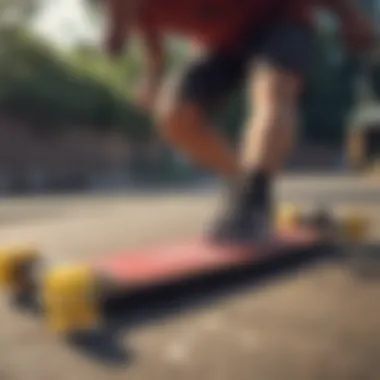

Stability is another critical factor in your choice of mount. High speeds can produce vibrations that might spoil your footage. Some mounts, like the chest and body mounts, tend to be more stable compared to helmet mounts. A secure and stable mount minimizes the shake and permits smoother footage.
The angle at which your camera is positioned also plays a significant role in the overall quality of the captured footage. A low angle may provide a thrilling perspective of the ground rushing by, while a higher angle can capture sweeping views of your surroundings. Adjusting these angles according to your chosen mount, synchronized with riding style, will enhance viewer engagement and enrich your storytelling through video.
Ensuring the right balance between stability and angle is key. Thus, remember to conduct thorough testing before hitting the steep hills, as optimizing these factors directly impacts the video quality.
Installing GoPro Mounts on Longboards
Installing GoPro mounts on longboards is a crucial aspect for anyone keen on capturing their thrill-seeking rides. It's not only about securing a camera but also about enhancing the overall filming experience. Proper installation ensures that the equipment captures stable and high-quality footage while minimizing the risk of damaging both the camera and the longboard. This section will guide you through the various aspects of installation, focusing on specific elements that can influence your recordings.
The benefits of a well-installed GoPro mount include improved video clarity and a reduction in unwanted vibrations and shakes. Each ride on a longboard can be different — from smooth paths to rugged terrain — which makes secure mounting even more critical. This section will dissect step-by-step procedures and ensure that your setup is as secure as possible, allowing you to concentrate on your ride rather than worrying about your camera.
Step-by-Step Installation Procedures
When installing a GoPro mount on your longboard, the process should be methodical. Here’s a straightforward approach to perform an effective installation:
- Clean the Surface: Before applying the mount, ensure that the longboard’s surface is clean. Use isopropyl alcohol to remove dust and grease. This will help the adhesive stick better.
- Choose the Right Mount: Depending on the filming angle and the desired perspective, select the right mount. For instance, a skateboard mount provides a direct view of the action, while a chest mount gives rider perspective.
- Positioning the Mount: Test various positions. The front of the board generally offers a wider view, but side positions can capture unique angles.
- Attach the Mount: Firmly press the mount onto the board, ensuring there are no air bubbles trapped under the adhesive.
- Let It Cure: Allow the adhesive to set for at least several hours, or overnight if possible. Follow package guidelines for best results.
- Test Attachment: Before your actual ride, gently tug on the mount to confirm it's secure. If it feels loose, consider reapplying or using an additional securing method like a zip tie.
Ensuring Secure Attachments
Overall, ensuring secure attachments is fundamental to preventing accidents that could endanger both the rider and the camera. Here are several considerations when making sure your mount is secure:
- Use High-Quality Adhesives: Not all mounts come with strong adhesives. Upgrading to industrial-strength tape or choosing mounts known for their durability can make a difference.
- Regular Checks: After several rides, check your mount for wear. Vibrations might loosen it, so it is wise to inspect it regularly.
- Additional Safety Measures: For extreme situations, consider using a tether. This can provide a secondary safety net should the adhesive fail.
In the realm of extreme sports, nothing can be left to chance. Following the above procedures can protect your equipment and ensure the footage you capture is as exhilarating as your ride.
Safety Considerations When Using GoPro Mounts
When engaging in longboarding, safety must remain a priority, especially when using GoPro mounts. Capturing thrilling moments while riding can enhance the experience, but improper mounting can lead to accidents or damage to both rider and camera. Therefore, understanding safety considerations is essential for every longboarder looking to document their rides.
Stability During High-Speed Riding
High-speed riding on a longboard offers an exhilarating experience but also demands more focus on stability. The choice of mount significantly influences how steady the captured footage will be. Uneven surfaces or sudden shifts can lead to vibrations that affect video quality, and in more concerning scenarios, result in the camera dislodging from its mount.
Riders must ensure that their mounts, whether helmet or skateboard mounted, are rated for the speeds they intend to reach. Using a quality adhesive or screw-based mount can enhance stability. Ensuring the mount sits flat against the equipment and the surface is clean can help maintain this integrity. Regular inspection of mounts before riding allows for the identification of any wear or potential faults that could affect stability.
Preventing Accidental Detachments
Accidental detachments pose a significant risk while filming with a GoPro on a longboard. These risks can arise from inadequate mounting techniques or insufficient testing before intense use. To reduce the likelihood of your GoPro becoming airborne, several practices should be adopted.
- Secure the Mount Properly: Ensure the mount is securely attached before starting the ride. This involves following manufacturer guidelines carefully.
- Use Safety Tethers: A safety tether is a wise addition. Attaching a tether from the camera to the mount acts as a backup should the primary attachment fail.
- Regular Maintenance: Over time, wear on the mounts and attachments may compromise their integrity. Regular maintenance and replacement are key to preventing accidents.
Remember that rider and equipment safety go hand in hand. Investing in quality mounts and proper techniques can significantly enhance the longboarding experience.
By prioritizing stability and preventing accidental detachments, longboarders can enjoy capturing their adventurous rides. Understanding these safety considerations not only enhances the filming experience but also minimizes the risk of accidents on the road.
Capturing High-Quality Footage
Capturing high-quality footage is crucial for any longboarder looking to document their rides effectively. A well-produced video can showcase skills, terrain, and the thrill of the ride. Moreover, quality footage enhances viewer engagement, whether for personal viewing or sharing on social media. In the realm of extreme sports, where every twist and turn can be significant, the ability to capture this in brilliant detail is vital.
Choosing Appropriate Settings
When configuring your GoPro for longboarding, selecting the right settings can make a substantial difference in video quality. Start by considering the resolution and frame rate. For crisp visuals, recording at 1080p at 60 frames per second is a solid choice. This setting offers clarity and smoothness, perfectly accommodating fast movements often observed in longboarding.
Another key setting is the field of view (FOV). Choosing Wide or Superview mode can give a more immersive experience, capturing a broader perspective of the riding environment. However, be mindful that these settings may introduce distortion at the edges. For actions like tight turns or tricks, a Linear setting helps reduce this effect, providing a more natural look.
Lighting can significantly impact video quality. Shooting during golden hour, right after sunrise or before sunset, can provide beautiful light conditions. In darker conditions, utilizing the GoPro’s low light mode can help, but it’s essential to be aware that video quality might slightly decline in less-than-ideal lighting.
Positioning for Optimal Angles
The positioning of your GoPro plays a massive role in the output quality of your footage. Different angles can dramatically affect how the ride is perceived. Testing various positions may also lead to uncovering unique perspectives.
- Front Mount: Attaching the GoPro at the front of the longboard can give a thrilling viewpoint, allowing viewers to see the path ahead.
- Side Mount: Placing the camera on the side can capture the thrill of riding, showcasing the motion from the rider's perspective. This angle is brilliant for dramatizing speed.
- Follow Cam: Using a friend or a drone to follow the ride can provide dynamic footage that captures both the rider and environment.
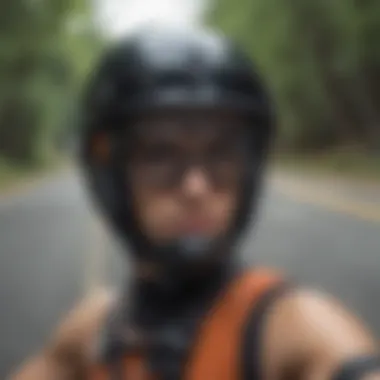

Experimenting with various heights can also yield different looks. A lower point of view tends to dramatize height and drops, while higher angles give a broader context of the surroundings.
Post-Processing and Editing Your Footage
Post-processing and editing are crucial steps in the journey of creating impactful videos from your longboarding adventures. A well-executed post-processing phase can elevate simple footage to engaging visual narratives. This expert craft involves various techniques that tailor the raw camera captures into polished and captivating stories.
One of the primary advantages of post-processing is the ability to enhance visual quality. After all, the raw footage taken by GoPro cameras might not always convey the emotional essence of the moment. Various software options exist to polish colors, adjust lighting variances, stabilize shaky shots, and add dynamic visual effects. These elements help you portray your longboarding experience vividly, drawing the viewer deeper into the thrill of the ride.
Another significant consideration in post-processing is syncing your footage with audio. Whether using onboard sounds or overlaying music, well-timed edits can amplify the excitement of your footage. This synchronization highlights important moments or transitions during your ride, making the video feel cohesive and purposeful.
To make the most of your editing experience, understanding effective techniques is paramount. In this section, we will explore the tools available as well as the skills necessary to excel in editing your longboard videography, ensuring you convey your adventures properly.
Selecting Editing Software
The choice of editing software is vital for an effective post-processing experience. Several options cater to different skill levels, from beginner-friendly programs to professional-grade editing suites.
- Adobe Premiere Pro: A leader in the industry, Premiere Pro offers extensive features like multi-cam editing and advanced color grading. It's ideal for those aiming for professional-grade output.
- Final Cut Pro: Apple users often prefer Final Cut Pro for its user-friendly interface and efficient performance. It allows for significant customization and offers a range of powerful tools.
- DaVinci Resolve: This software is known for its advanced color correction capabilities. While it may have a learning curve, it’s free for basic use, making it suitable for beginners.
- iMovie: For those seeking simplicity, iMovie provides basic editing features while being easy to navigate, perfect for newcomers to video editing.
When selecting software, consider factors such as your editing goals, budget, and existing knowledge. Whether you want to create a simple montage or a detailed documentary record of your experiences, the right editing software helps you achieve your vision.
Enhancing Video Quality
Enhancing video quality is often seen as a pivotal element in editing. Here are some practical techniques to improve the final output of your longboarding footage:
- Stabilization: Use built-in stabilization features or plugins to smooth out shaky footage. This is critical, especially for action sports videos, where movement is rapid and unpredictable.
- Color Correction: Adjust brightness, contrast, and saturation levels to make the colors pop. Natural lighting conditions can affect color fidelity, so correction is often necessary.
- Trimming and Cropping: Focus on essential parts of your video. Eliminating unnecessary sections keeps the viewer engaged and maintains interest throughout the footage.
- Sound Design: Good audio enhances video quality. Use background music or voice-overs judiciously to guide the narrative without overshadowing natural sounds or emotions present in the clip.
Incorporating these enhancements can make a significant difference in how your audience perceives your longboarding adventures. Pay careful attention to these details to capture the distinct essence of your experience consistently.
"Through the lens of creativity, simple footage can transform into a powerful story."
By prioritizing the post-processing phases, you ensure that your longboarding footage not only documents your experiences but also tells a compelling story. Ensure you are equipped with the right tools and knowledge to elevate your editing skills.
Common Mistakes to Avoid
When engaging in the thrilling world of longboarding with a GoPro, it is crucial to recognize common pitfalls that can impede your filming experience. Understanding what not to do can be just as important as knowing the right techniques. This section explores some errors that can affect the quality of your footage and underline the importance of careful preparation.
Incorrect Mounting Techniques
One of the primary mistakes longboarders make is improper mounting of their GoPro. A secure mount ensures that the camera stays in place, capturing the desired footage without unintended shakiness or loss of perspective. Common errors include:
- Failing to clean surfaces: Dirt or debris on either the mount or the longboard can lead to inadequate adhesion, risking the camera’s security during rides.
- Using unsuitable mounts: Each mount is designed for specific uses. For instance, a helmet mount may not perform well on a longboard, where a handlebar mount might provide a more stable viewpoint. Selecting the wrong type can lead to poor quality recordings.
- Poor angle selection: Mounting the camera at an inappropriate angle can distort the video. Ideally, the mount should allow the camera to capture the action without skewing the horizon.
By adhering to these principles, riders can significantly enhance their filming reliability. It is advised to spend time testing mounts before heading onto the trails.
Neglecting Safety Precautions
Safety should always take precedence while recording your rides. Neglecting safety precautions can lead not only to damaged equipment but also to personal injury. Here are some vital considerations to keep in mind:
- Using the right safety gear: A helmet is essential, not just for your safety but also to provide a protective buffer for the camera if it happens to become dislodged during extreme maneuvers.
- Ensuring mount stability: Before each ride, double-check that the mount is secure. A loose mount can lead to detachments and create hazards both for the rider and others nearby.
- Awareness of surroundings: Filming while riding can be distracting. Maintaining awareness of your environment is key to avoiding accidents. Focus should remain on both the ride and the camera, ensuring that neither contributes to an unsafe situation.
By actively observing these issues, riders can improve their filming experience while also prioritizing safety as an essential component of participating in extreme sports. As the thrill of longboarding blends with the adventure of filming, attention to these potential mistakes can lead to fulfilling and secure outings.
Final Thoughts on Longboard GoPro Mounts
Using GoPro mounts on longboards can significantly enhance the overall experience of documenting extreme sports activities. This guide emphasizes the importance of selecting the right mounting solution and adhering to proper installation techniques. The information covered throughout this article offers valuable insights that can help riders optimize their footage quality while maintaining safety.
The Importance of Documentation in Extreme Sports
Documentation serves a critical purpose in extreme sports, particularly for longboarders. Recording your rides not only allows for personal reflection but also contributes to the broader community by showcasing skills and experiences. High-quality footage can inspire newcomers and amateurs in the sport. It reflects the essence of adventure and fosters a sense of belonging among enthusiasts.
Moreover, documentation can help track progress. By reviewing past videos, riders can identify areas for improvement, adjust techniques, and celebrate milestones. Consistently documenting sessions provides a way to assess performance over time, giving valuable insights into one's growth as a longboarder. In essence, capturing these moments helps in both personal and communal perspectives of the sport.
Embracing Innovation in Gear Setup
Innovation in gear setup is fundamental for staying current with trends in extreme sports. The fast-paced nature of technology is constantly introducing new products, improving existing ones, and enhancing user experiences. Longboarders should remain adaptable and open to integrating these advancements into their filming practices.
The range of accessories and mounts available today offers countless possibilities for creating unique video perspectives. Adopting modern techniques not only helps produce more engaging content but also showcases the rider's creativity and technical proficiency. This evolution in gear setup resonates with the audience, providing fresh angles and viewpoints on familiar concepts.
By experimenting with innovative mounts and camera placements, riders can push the boundaries of what is possible in video capture. This exploration might reveal new ways to capture adrenaline-filled moments, making footage more thrilling and captivating for viewers.
"When documenting your rides, remember that your creativity in gear setup can lead to spectacular footage that inspires others in the sport."




